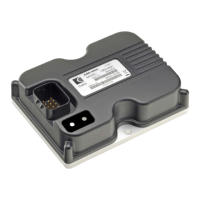20
Curtis 1352 eXm Manual, R ev. D
with the least significant byte placed in data byte 5 and the most significant byte
placed in data byte 8.
SDO eXm Response, SDO-TX (MISO)
An SDO request is always acknowledged with a response message from the
eXm. The eXm can issue two kinds of response messages: a normal response
or, in case of an error in the request SDO, an Abort SDO Transfer message..
SDO-TX (MISO) (sent by the eXm in response to the system master)
Byte 1 Byte 2 Byte 3 Byte 4 Byte 5 Byte 6 Byte 7 Byte 8
Control CAN Object Index Sub-index
Data: either the requested Read values, or the
actual Write values, or an error code
The first data byte of the response contains an acknowledge code, which
depends on the type of transfer that was initially requested.
Action
Byte 1
Value
Read Response 40h
Write Acknowledge 60h
Abort SDO 80h
Data bytes 2, 3, and 4 hold the CAN Object index and sub-index of the
request SDO.
If the SDO was a read command (a request for data from the eXm),
data bytes 5 through 8 will be filled with the requested values, with the least
significant byte is data byte 5 and the next least significant in byte 6 and so
forth. All unused bytes are set to 0.
If the SDO was a write command, data bytes 5 through 8 will return back
the actual value written in bytes 5
– 8. In this way, if the eXm needs to limit or
round-down the SDO write request, the master will know—because the return
value will be different than the sent value.
If the SDO-RX (MOSI) did not properly read or tried to access a param-
eter improperly, an Abort SDO Transfer will be sent. Data bytes 5 through 8
will be filled with a 32-bit error code.
06020000h = Object does not exist
06010002h = Attempt to write to a read only object.
TYPES OF SDO OBJECTS
Three types of SDO objects are described in the following pages: Communications
Profile Objects (address range 1000h), Device Parameter Objects (address range
3000h), and Device Monitor Objects (address range 3100h).
5 — SDO COMMUNICATIONS

